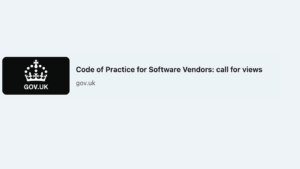
Uninterrupted access: The importance of offline capabilities to critical public sector services
Lead service designer Sam Gormley examines how the seemingly simple offline capabilities can help public sector organisations deliver essential services, even during disruptions.
In today’s digital world, everyone expects a stable, fast internet connection. But we all know internet outages happen.
I know I’m not the only one who still experiences some connection issues when working from home in Central London. It’s worse in remote parts of the UK where getting a decent connection can be a struggle.
It’s not such a big deal if I have to pause my Slack message or return to a document later. But what if I was part of a team operating and providing critical services for a government department? Here, even a minor loss of connectivity would have a huge knock-on effect on operations and cause significant disruption.
These might seem like problems we’d hope were forgotten with the wonderful new world of fibre optic broadband. But it’s not always the case.
Many critical public services operate in the ‘field’ where internet connectivity can be unreliable, and even stable office environments sometimes suffer IT outages.
The House of Lords Digital Exclusion paper reported that “there are significant geographical variations in digital access. Rural areas remain more likely to face difficulties accessing a decent internet connection.” Along with access, the paper also highlighted other factors that make it difficult for large parts of the population to get stable internet access, including affordability and ability.
Why public sector struggles with offline service technology
Of course, offline functionality in our everyday lives is common — think of Spotify or Google Docs. Increasingly, the public sector is looking to create products and services that can do the same.
For government organisations, implementing these functionalities can be a challenge due to infrastructure and regulatory constraints. Unlike consumer products, government services often deal with restrictive legacy technology, sensitive data and have tighter security measures.
Despite the unique complexities they face, these organisations are making real efforts to tackle the issue.
Because the benefits are clear. Connectivity issues or outages can cause operational disruptions, reputational damage and pose a security risk.
Unreliable connectivity can also result in usability challenges. For example, social workers in Nottinghamshire were reluctant to use a digital solution because of inconsistent 3G access. An offline mode addressed this adoption barrier.
As more business processes move online and away from manual, paper-based methods, having redundancy measures that maintain digital operations is hugely beneficial, especially for critical services.
READ: Agile government: Delivering high quality outcomes with tiny teams
What we did with ‘service workers’
In a recent project, we created an offline mode that allows the service to operate without the internet and synchronise when connectivity is restored.
The technology we chose to use is a ‘service worker’. When a user operates the service for the first time, the ‘service worker’ downloads the data and stores it within their browser using indexDB. This acts as a local database for the user. So, if they lose internet, the service still gives them access to the information they need.
The user can also make changes, which the ‘service worker’ stores. Once connection resumes, the information synchronises and keeps everything up to date.
It increases accessibility and operational continuity and enhances user experience by reducing the load and lag times associated with poor connectivity.
We’ve had lots of interest from clients when showcasing how we’ve introduced the solution alongside a workflow application that drives business processes. We’ve used service workers in other work for government organisations, for example, on a website to ensure that critical government guidance can still be accessed during a serious internet outage.
Given that many readily available open-source service workers are from Google, implementing an offline mode doesn’t necessarily require huge budgets.
Tips on implementing offline service capabilities
When designing and building offline mode for government services, it’s important to consider a few elements.
- Design offline capabilities from the start: Design the service with offline mode as a core consideration. The decisions made during this early stage will influence the effectiveness of the offline experience, from page flow to technical stack compatibility with service workers.
- Communicate clearly: Losing connectivity can be troubling for the user. Within the design of the service, give clear instructions on how the application will operate when connection drops to manage expectations. UX and content designers play an important role in ensuring the tone and messaging are correct.
- Focus on the right features: Having the entire service available offline might not be necessary. Really understand the user, the tasks they complete most frequently, and the points in the journey at which they might struggle or lose connection. This will help refine what needs to be available offline first and put the focus on the high-value areas.
At Zaizi, when we build digital services, if our research indicates users may encounter poor internet connectivity, we ensure our solutions address that problem. If you would like to learn more about offline capabilities, service workers, or a specific case study I’ve mentioned above, feel free to get in touch with me.
Like what you read? Sign up for our Digital Insights newsletter to stay up to date with all the latest developments in digital government.
-

New report shows how the Labour government can avoid the policy-delivery gap
-

Digital-first governance: Reflections on the first week of a Labour government
-

Why digital deliverability must be a key test for policy post-election
-

Bringing an SME perspective to government’s Code of Practice for Software Vendors
-

How to design thoughtful and secure cross domain workflows
-

What is a cross domain workflow and why does it matter?
